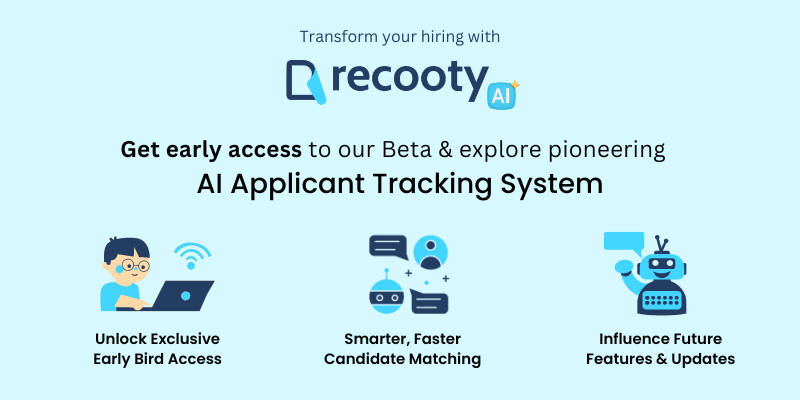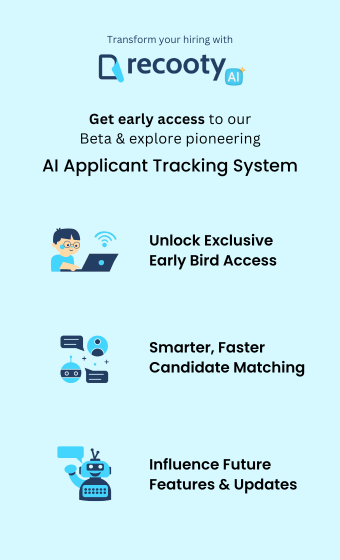
Today’s tight job market means finding, recruiting and retaining the best candidates is difficult. Companies must develop a solid talent acquisition strategy with a candidate-centric mindset to win the talent war.
In other words, hiring quality talent today requires companies to implement carefully crafted recruitment processes. This article provides tips and steps for a successful hiring process.
What is Recruitment?
Recruitment is the process of finding, screening, hiring and ultimately retaining qualified applicants. The hiring process is very simple, but technological improvements, a tight job market, and a worker pool that may span five generations can make the first step of locating potential employees quite tough. Hiring is a central part of HR management and is supported by hiring managers and other people involved in the hiring process. Skilled recruiting makes a company stand out from the rest and is more attractive to potential employees. This is a strategy that directly affects a company’s bottom line.
What is Recruitment in HRM?
Human resource management, also abbreviated as HRM or HR, is the human resource management function within an organization. The Human Resources department is responsible for supporting the organization’s overall goals through effective management of human capital, centered around the company’s most important asset: its employees.
It is the initial stage in creating an organization’s human capital. In general, the goal is to locate and hire the best applicant within your time and financial constraints.
How are Recruitment activities carried out?
Organizations can develop a recruitment strategy to ensure that their activities are well thought out, effective and efficient. Strategies may include aspects such as the size of the organization, the overall economy, competition from similar candidates, organizational attractiveness, labour laws, and other legal aspects.
In general, the hiring process is similar for any organization. However, the number of steps in the process and the tasks involved may vary. For example, one organization may require candidates to complete a pre-employment assessment while another organization does not.
What is Recruitment process steps
A step-by-step manual of the recruitment process helps companies accompany this process. Depending on your role, company structure, and industry, the steps may vary. However, the hiring process is typically:
1. Determination of recruitment requirements
The first step in the hiring process is for HR and other decision makers to clearly recognize the hiring need. Whether you’re replacing a retired employee or creating a new position, the hiring process begins as soon as long-term or short-term hiring needs are identified.
2. Create a job description
Once you’ve determined that you need to hire new employees, the next step is to set job descriptions and standards. The job description includes:
- Title and Department duty
- Preferred qualifications and skills
- location and opening hours
- Company Profile
- Salaries, Benefits
- Creating a comprehensive job description with clearly defined responsibilities lets potential applicants know what they need to bring to the job to meet their requirements.

3. Candidate search
Companies can choose to hire people who:
- Internal talent pool – promotions, transfers, ex-employees, employee referrals
4. Selection and selection of applicants
To move on to the next stage, examining, evaluating and reviewing applicants along with cover letters, resumes and other documents is essential to finding top notch employees. Technology and software such as the Applicant Tracking System (ATS) can streamline and speed up this process.
Also Read: Best Recruitment Techniques To Find The Right Talent
5. Interview phase
Interviews require careful planning and preparation. The first step in this phase is to create a list of standardized interview questions. Next, you need to decide what the interview process will be like, how many interviews the candidate will have to undergo, and by whom and how they will be conducted. Companies can conduct phone interviews, video interviews, or traditional face-to-face interviews.
6. Selection of new employees
After meeting a variety of interviewees and potential candidates, select the candidate that best fits the role and company culture. Make sure the candidate’s qualifications and credentials are verified before proceeding to the next step.
7. Extend offer
Once a candidate is selected, the hiring team prepares an offer letter. Salary and benefits negotiations and back-and-forth discussions may take place at this stage, but they end with the candidate signing an extension offer.
8. New employee onboarding
Onboarding aims to integrate new hires into their peers, company culture, policies, etc. and is an important step in employee retention. A carefully crafted positive employee experience increases new employee loyalty and reduces absenteeism and start-up time.
Recruitment Type – Recruitment Method
From internal promotions to external referrals, it’s important to adapt your hiring methods to find the right candidates. Here’s an overview of some standard practices.
- Internal Hire: Appoint existing employees within your organisation to fill vacancies.
- Retain Recruitment: A method of searching and selecting the best candidate for a company by requesting an external organisation. By paying an up-front fee for recruiting activities, but we may pay additional fees after a candidate is hired.
- Urgent Recruitment: This option includes hiring a third party to do the hiring on your behalf. However, you only pay a fee if qualified candidates are hired.
- Staff Recruitment: which also involves external recruiters, is frequently utilised to fill short-term or temporary employment.
- Recruitment for Re-employment: This type of recruitment may also be offered to employees who have been involuntarily terminated. In addition to other services provided by outplacement agencies, it is also used to help retirees find employment.
- Recruitment process outsourcing (RPO): In this case, the organisation outsources the recruitment function entirely to a third party. The main goal is to reduce the cost of the recruitment process.
- Temporary staffing professionals: Rather than hiring a full-time recruiter, you can also hire temporary employees or consultants to help your hiring team from time to time.
- Career Fair: Whether in-person or virtually, these events provide companies with the opportunity to meet with qualified candidates and promote their employer’s brand.
- Recruitment on campus: Participate in on-campus recruitment events to help recruit new graduates and dual students.
- Employee development and succession planning: Developing employees and preparing them for new roles is a great opportunity for employees and reduces the risks associated with external candidates.
Top Recruitment Trends in 2024
Staying current on trends is critical for organisations looking to attract and retain great employees. As the year progresses, it is critical to discover the Recruitment trends in 2024 that will shape the business.
1. Remote work
By offering remote work and flexible scheduling options, you can effectively attract top talent and improve retention for your current workforce. The organisation evaluates the candidate’s ability to work independently, collaborate virtually, and adapt to a remote working environment. Remote work and flexible schedules will therefore be one of the top hiring trends in 2024.
2. The role of artificial intelligence in recruitment
One of the most important tools to have a major impact on AI is the applicant tracking system, also known as ATS. 2024 is, and will continue to be, the year of automation for the world of recruitment and staffing. AI-powered recruiting automation enables recruiters to analyze resumes, post jobs across multiple platforms, manage recruiting workflows, schedule interviews and more with just a few clicks.
3. Emphasis on diversity, equity and inclusion
Diversity, equality and inclusion practices are no longer just trends, they are imperatives for organizations around the world. This has had a direct impact on talent acquisition and hiring strategies, as today’s candidates are more conscious of the work environment in which they want to work.
4. Strengthen the employer’s brand
We all know that employer branding is paramount to attracting top talent, and it will be even more important in 2024. The stronger your brand as an employer, the more attractive your top talent will be, and your employee retention will be taken to the next level. Candidates today are very picky about who they want to work for. They have access to a wealth of information about companies through online platforms and websites with employer reviews.
5. Recruitment on social media
Over the past decade, social media has been an important part of the recruiting world. This will continue to be a significant part of the top hiring trends for 2024. Social media channels such as LinkedIn, Twitter, and Instagram have been and continue to be great sources of information to attract top talent. Social media can be very useful for targeting specific audiences, industries, and skills. This maximizes your chances of attracting qualified candidates
Recruitment Tips To Optimize Your Hiring

- Consider hiring in-house staff: There is always a chance that there is someone in your organization that you need. Internal prospects have the advantage of being familiar with your company’s culture, methods, and databases.
- Find a calm candidate: Candidates may be reluctant to apply through job sites because they are happy with where they work. Encouraging ongoing networking at conferences, colleges, and other career centers can help maintain professional connections and potentially lead to recruitment of these silent candidates.
- Look for people with a proven track record: Hiring candidates who have already performed well in the same position at another company can help fill vacancies in your own company. This can be done by replying to the applicant’s online resume or by introducing the applicant to the company yourself.
Recruitment Tip #1 – Tailor Your Recruitment Process For Different Roles
We know, you definitely already have a structured recruitment process in place. However, in today’s competitive market, you need to pick up the pace and eliminate every shortcoming. We’ve analyzed many companies’ recruitment processes. So, the most common shortcoming that exists is they have the same hiring approach for every role and position.
Tailoring your recruitment process to accommodate different roles is one of the most important recruitment tips that we have to share. It is essential for employers to understand that hiring for different roles requires different approaches. You need to accelerate your hiring process and customize it for different roles. By streamlining and tailoring your approach, you can ensure a seamless and effective recruitment experience for both candidates and hiring teams. This will help you attract candidates from different, rich backgrounds and competencies.
Recruitment Tip #2 – Develop An Outstanding Culture
Having a good culture is important for your hiring process. This is probably a sentence you might hear and read everywhere. There is a reason behind this. Investing in outstanding company culture, that makes candidates want to work for you, is a traditional and extremely important recruitment technique.
While company culture may seem to be an outdated concept, the truth is, having a strong identity can go a long way when it comes to attracting candidates. You need to invest mindfully in developing a nurturing and positive company culture. This will make talented prospective employees want to be a part of your company and give their best.
Recruitment Tip #3 – Digitize Your Recruitment Process
Yes, you read that right! The global recruitment process was already on its way to shifting to digital before, the pandemic just fueled and accelerated the process. Recruitment today, and in the post-pandemic world is entirely digital. So, you need to boost your digital hiring processes and strategies to get noticed by the top talents out there.
Digital hiring includes a wide spectrum of components. For starters, for hiring for different roles, you need to explore niche job boards. It’s where the finest of the candidates showcase their talents. Also, investing in an Applicant Tracking System, that is suitable to your needs, can be the best thing that can happen to your digital recruitment.
Recruitment Tip #4 – Improve Your Employer Branding
Employer branding is a topic that everyone talks about but no one seems to know what it means. An organization’s reputation and popularity as an employer are what is commonly termed an Employer brand. The employer brand is what sets a company apart from others. It shows the prospective employees why they should work for them. It effectively reflects a company’s values, culture, and mission.
The top talents definitely consider the company’s reputation and employer branding before applying for a job. Companies that do not focus on their employer branding ideas usually struggle in attracting as well as retaining candidates. So, employer branding is a very important recruitment strategy.
Recruitment Tip #5 – Focus on Recruitment Marketing
Attracting the right talent can be really daunting, especially in today’s competitive market. So, recruiting marketing is an amazing technique to put your company’s culture and values out there. You need to not only build your reputation by enhancing employer branding but also focus on getting candidates to notice you. So, just like employer branding, recruitment marketing should also be an important part of your hiring strategy.
The most common recruitment marketing tactics include creating content specifically for your target audience, tweaking your careers page, and advertising your job openings. Also, you need to keep your company’s profile updated on social media to expand your exposure.
Recruitment Tip #6 – Emphasize Employee Referral Programs
One of our most important recruitment tips for you is to make complete use of the power of employee referrals. An employee referral is basically an employee referring an individual from their professional network for an open role in your company. While traditional methods have their place, emphasizing employee referral programs can unleash a wave of talent that you never knew existed. You can consider improving your employee referral programs by implementing a bonus system for successful hires, or any other tangible benefits for your employees.
Implement an employee referral program to encourage your current employees to refer qualified candidates. Provide incentives, such as referral bonuses or recognition, to motivate employees to actively participate in the program. Employee referrals often lead to successful hires and can significantly reduce recruitment costs.
Recruitment Tip #7 – Provide a great candidate experience
You’ve probably heard too much about improving your candidate experience as one of the important recruitment tips. This is because poor candidate experience can truly be very damaging in the candidate-driven market that is today. The process of enforcing a positive candidate experience begins right at the point of sourcing candidates.
The interactions a potential employee has with everyone at the organization, from recruiters to hiring managers and human resources specialists, will determine how they view and feel about the hiring process. A positive candidate experience also includes other things like the ease with which they were able to send out an application and the quality of communication throughout the hiring process also matters.
Recruitment Tip #8 – Consider Hiring Internally
Hiring internally is probably one of the most efficient and cost-saving recruitment tips that we have for you. If you’re not doing so already, you should really consider hiring internal talents. Recruitment is often considered an external exercise. However, there is a good chance that the perfect candidate for a role is right there within your team. Instead of always looking outside the company for new talent, exploring internal opportunities can bring a range of benefits.
Hiring from the internal workforce can help you ensure that you are filling the vacant position with someone who is already familiar with your company’s culture, mission, and objectives. Promoting an internal resource to an open role can boost the employee morale of your workforce. Internal recruiting also shows that you’re invested in the continuous development of your employees.
Recruitment Tip #9 – Adopt Collaborative Hiring
Collaborative hiring is the next best thing in this list of recruitment tips. Collaborative hiring is an approach that involves bringing together professionals from different departments, including hiring managers, team members, HR professionals, and even potential colleagues of the new hire. This collaborative effort ensures that diverse viewpoints are brainstormed, and a comprehensive evaluation of candidates takes place.
Collaborative hiring offers a range of benefits that can positively impact your recruitment process. Firstly, it promotes a sense of ownership and engagement among team members. When employees are involved in the hiring process, they feel valued, as their opinions and expertise are sought after. This leads to increased employee satisfaction and a stronger sense of teamwork.
Recruitment Tip #10 – Embrace remote work and flexible schedules
The fact that the pandemic has changed the way we work cannot be stressed enough. The world of work has undergone a significant transformation, with remote work and flexible schedules becoming increasingly prevalent. When the pandemic hit us, remote work was a necessity to keep things running. However, when the pandemic has subsided now, remote work is now a choice of employers, as well as employees. So, one of the most relevant recruitment tips in today’s world would be to provide an option for remote work to potential employees.
By offering remote work options, you can open yourself up to a range of benefits. You can tap into a broader talent pool, breaking down geographical barriers. So, you can access candidates from various locations. This widens your reach and allows you to find the best fit for your organization, irrespective of their physical proximity to your office. Moreover, flexible schedules enable employees to manage their work and personal commitments effectively, leading to higher job satisfaction and increased productivity.
Why Recruitment is Important?
Recruitment is an important process for any business that offers a multitude of benefits. Here are some top benefits of recruitment:
Enables companies to hire the best talent
The recruitment process needs HR professionals to find out candidates who possess the right education, skills, and experience for an open role. They achieve this by leveraging an applicant tracking system (ATS), interviewing technical interviews, and further assessment techniques.
Attract people who can resonate with company principles
If a company has a robust recruitment process, it lets its HR professionals ascertain if a candidate thinks in favor of the company’s values and also its culture.
For instance, by finding and then interacting with candidates, HRs can hire the ones who value their company’s atmosphere and can thrive in it once joined. Additionally, it positively affects employee retention and job satisfaction.
Builds a talent pool for future hiring needs
When successful hiring is made, HR professionals can keep their details and stay in touch with the candidates who weren’t selected but are qualified and have potential. So when they need to hire they can invite them for the open position.
Ensures hiring of people who can push the business forward
HR professionals, when searching candidates for an open role, use resources at their disposal to connect with people with the skills and qualities who have the potential to contribute to fresh business endeavors or goals.
For instance, recruiters gather a candidate pool specifically for the IT department within the organization.
Improve morale and employee retention rates
A strong recruitment process can enhance morale in the workplace by bringing in individuals who can fit well with the existing people and the culture.
Additionally, when a company is invested in bringing the right fit, it shows employees that the company takes proper care of its existing people and is making an effort for their development.
This results in increased satisfaction and engagement of employees which eventually leads to better retention rates.
Conclusion
At its most basic, recruiting is a straightforward idea that entails locating individuals and hiring them to fill open positions. However, effective recruitment combines a bit of art and science. On the one hand, it requires the implementation of repeatable processes that lead to reliable results. On the other hand, finding the ideal candidate requires the ability to think outside the box.
Thank you for reading!
More Related Topics:
- 10 Steps to a Successful Recruitment Process
- 9 Effective Recruitment Strategies in 2024 That You Should Be Aware Of
- Social Media Recruiting: A Complete Guide for 2024
- Recruiting vs Talent Acquisition(Updated 2024)
- 10 Steps to a Successful Recruitment Process
- 5 Most Common Recruitment Myths
- The Best Recruitment Tools For Modern Recruiters In 2024
Frequently asked questions
Human Resources is a company’s department in charge of all personnel and employee-related operations. We can use the phrase to refer to an organization’s entire workforce. This HR definition will focus on human resources as a corporate function.
The organization’s life system consists of the processes of recruitment, reward, retention, and retirement (the 4Rs). People who come from other organisations in this category are tuned to that specific socio-cultural milieu, and if they uncover an anomaly, instead of enhancing productivity, they will become a burden in the new set up. To avoid this, HR functionaries should exercise extreme caution when carrying out recruitment functions in a methodical and specified manner, so that the new entrant finds no discrimination between his previous and current employment.
If you do not take the time to learn, you will not have all of the necessary knowledge and will eventually fail. Another reason for recruiting failure is that recruiters rarely spend time cultivating connections. Everyone believes that recruiters are simply salespeople looking to make a quick cash.
Strategic recruiting is finding the right people by combining three factors: Qualified Sales, Employer Branding, HR Marketing. It is a recruitment-focused marketing approach used to find the greatest employees for a firm to succeed in a volatile market.







